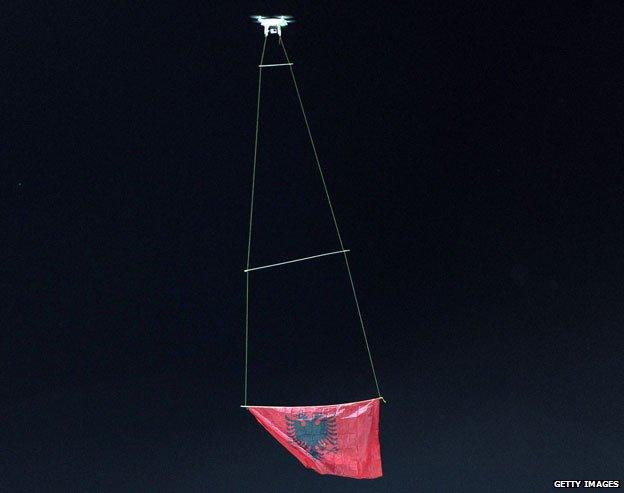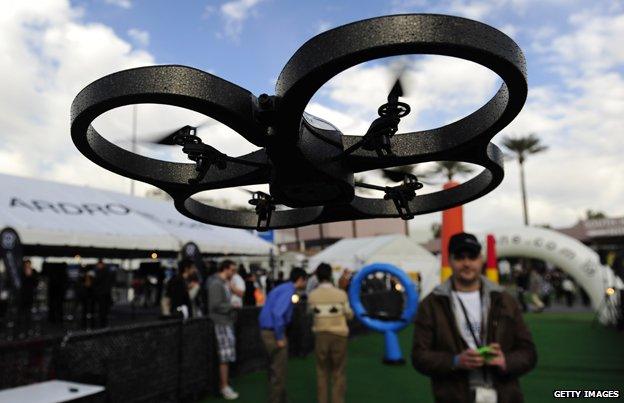Where you can and can't fly a drone
- Published
What are the rules for drone use in the UK?
Thousands will receive drones as Christmas presents this year but, as a recent near-miss with an airliner shows, the authorities face a battle to stop them being used irresponsibly.
Unmanned aerial vehicles (UAVs) or drones have long crossed over from just being used in the military and specialist commercial sphere. They can now be seen in homes.
Remote controlled aircraft used to be a niche hobby. It took time to build them and skill to operate them. Today drones are cheap, quick to get in the air and you can operate them on a smartphone or tablet. Today the thrill is not so much operating a model aircraft as having a flying camera.
Across the world, rules are being drawn up or refined to deal with the potential dangers. But they are already being flouted.
An unidentified drone came close to hitting an Airbus A320 as it landed at London's Heathrow during the summer.
The Civil Aviation Authority (CAA) sets the rules on drones in the UK under what is called an air navigation order.
An unmanned aircraft must never be flown beyond the normal unaided "line of sight" of the person operating it - this is generally measured as 500m (1,640ft)horizontally or 400ft (122m) vertically
An unmanned aircraft fitted with a camera must always be flown at least 50m (164ft) distance away from a person, vehicle, building or structure
An unmanned aircraft fitted with a camera must not be flown within 150m (492ft) of a congested area or large group of people, such as a sporting event or concert
For commercial purposes, operators must have permission to fly a drone from the CAA
In the US, the Federal Aviation Administration bans the flying of unmanned aircraft, including hobby drones, above 400ft, external.
The FAA also states that, if they are to be used within five miles of an airport, external, its air traffic control tower should be notified in advance. They should not weigh more than 55lbs (25kg).
The European Aviation Safety Agency is developing EU-wide safety standards, external, which it says will be as high as those for manned aircraft.
Recent evidence suggests the rules are being flouted in the UK either because people are unaware or are wilfully ignoring them. Videos uploaded to YouTube show them being operated above London, Nottingham, Liverpool FC's Anfield stadium and towns including Margate and Broadstairs in Kent.

The CAA has prosecuted two Unmanned Aerial Vehicle (UAV) operators relating to safety breaches. It has four other investigations pending. The Association of Chief Police Officers was unable to say how many prosecutions the police have made over drones. But there have been arrests, such as that of a man from Nottingham in October for flying a drone over Manchester City's stadium during their game against Tottenham Hotspur.
Ch Insp Chris Hill, said: "Even small drones can weigh up to seven or eight kilograms and could cause damage or injury if they fall from height. Thankfully, no-one was hurt."
The CAA's focus is purely safety. For the criminal use of drones, including harassment, anti-social behaviour or damage to property, it is a police matter. If people have concerns about a drone being flown in public they should call the police, a CAA spokesman says. "Local police can assess the situation in real time and, if there is any evidence of breaching the air navigation order, they will pass on any information on to us."
During the ongoing House of Lords select committee inquiry on remotely piloted aircraft systems, Chief Inspector Nick Aldworth of the Metropolitan Police said: "We do not have a criminal privacy law in this country, so it is not the concern of the police to try to develop or enforce it."
But drones could breach other legislation, he added. "The most obvious example to date is the Sexual Offences Act 2003 and the specific offence of voyeurism."
Incidents across the world are growing in frequency and political campaigners are using them to make a statement. In October a Euro 2016 qualifier in Belgrade was stopped after a drone trailing an Albanian flag was flown over the stadium. And in France, nuclear power stations were buzzed by drones, external in a number of mysterious incidents.

In the US, the Federal Aviation Authority places limits on drone activity. In July two men in New York were arrested after allegedly almost flying their drone, external into a police helicopter.
So what can be done to prevent the growing number of incidents eventually ending in tragedy?
The British Airline Pilots Association (Balpa) is campaigning for drones to be programmed not to enter certain airspace - known as geo-fencing. The Phantom series of drones, sold by manufacturer DJI, already includes geo-fencing. The GPS of the drone is programmed with the co-ordinates of thousands of airports around the world. It cannot enter these areas. If it tries to it will be forced to land. And within a 2km radius of a major airport its height will be capped at just 10m.
Critics, like Dave Phipps of the British Model Flying Association, point out that people can buy a drone online from a manufacturer that doesn't use geo-fencing technology. "If you're buying it from the Far East it's virtually impossible to enforce." And other people could simply build their own drones. "You could even buy it in component form and assemble it yourself."
Commercial operators undergo days of training. But hobbyists can take it out of the box and fly it like a toy. People may need more education on what the rules state, Phipps says. Once they are aware, most users will use them in a responsible way. But stronger punishments may be necessary to send a message to "the idiot contingent", he says.

The police in the UK have so far been relatively tolerant. Ch Insp Aldworth told the House of Lords committee that US and Korean tourists had been caught flying drones in parts of London where they shouldn't have been. "We have decided not to enforce the legislation that exists, even though they were in contravention of it because it did not seem proportionate."
Phipps says the authorities need to take a tougher line where the rules are broken. "They should carry out a few more high-profile prosecutions." And beef up the penalties, he adds. "The fines have been fairly insignificant. Internet posters have said it's almost worth the risk because you'll just get an £800 or £900 fine."
Another new step that Balpa is calling for is that, just like with a car or television, people purchasing a drone would have to give their personal information to the retailer and that this information should be logged. If a drone is apprehended the owner can then be traced. With illegally flown drones at the moment, even if you can apprehend the drone, it may prove hard to catch the person operating it.
Michael Perry, a spokesman for DJI, says the company is discussing compulsory licensing with regulators. All its products have a serial number that can be traced, he says. But would a Chinese manufacturer like DJI co-operate on such a system with European governments? "We're an international firm. It does behove us to work together with industry regulators," he says.
Phipps is sceptical. Even if some firms do play ball there is nothing to stop people going online to order unlicensed drones from abroad, he says.
Stricter height limits built in by manufacturers are another suggestion. Perry says that the Phantom 2 is capped to a height of 122m (400ft) when it's taken out of the box. Somebody can then tick a box to make it go up to 300m. If you build a drone at home you could in theory set it to reach 2,000m high.
The drone revolution has many potential benefits as well as risks advocates say. Perry points out the good that could come for farmers and search and rescue operations. In the UK, the CAA says it has issued permissions to 350 organisations to fly drones for business purposes, including the BBC.
In December 2013 Amazon announced it was testing unmanned drones, called Octocopters, to deliver goods weighing up to 5lb (2.3kg). But the CAA spokesman says the online retailer's plan is "flawed", for the UK at least. Drone operators must have a line of sight to the drone, meaning Amazon would only be able to deliver within a radius of 500m from the warehouse. Without a change in the law it remains just a clever idea.
But the skies are going to get busier. And just as with the first cars on the roads, accidents may be inevitable. And then more rules, driving tests and drone policing may become necessary.
Subscribe to the BBC News Magazine's email newsletter to get articles sent to your inbox.
- Published10 May 2013
